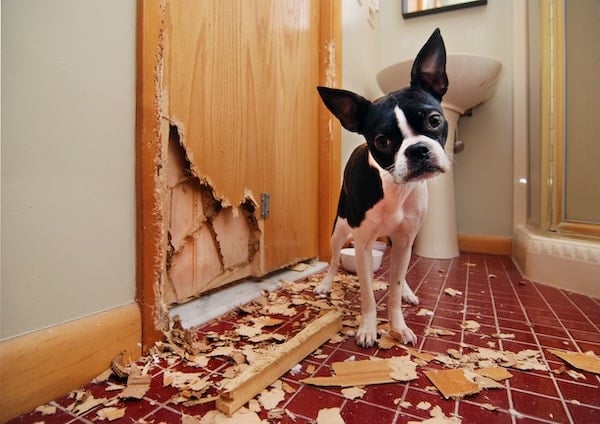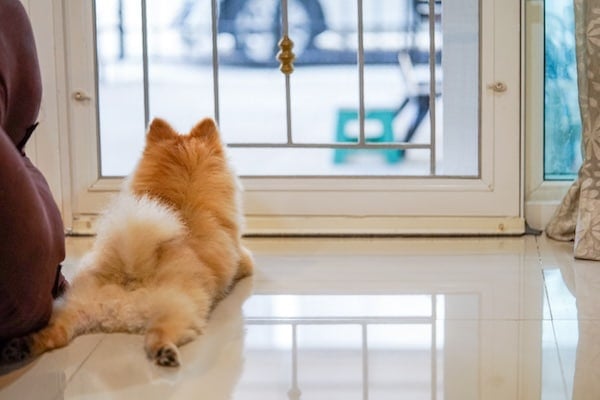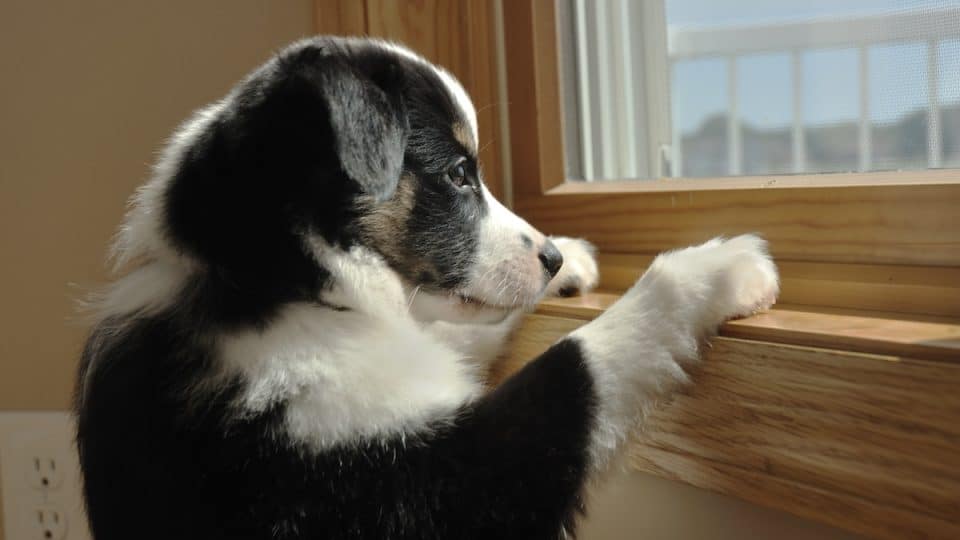- Not a substitute for professional veterinary help.
Does your puppy go into a panic when you leave the house? Or maybe they destroy their crate or even try to escape from it. It’s normal for a new puppy to feel a little nervous in their new home, but intense fear of abandonment is a hallmark of puppy separation anxiety.
Unfortunately, separation anxiety isn’t something your puppy is likely to outgrow without intervention. While socialization can help, separation anxiety usually requires targeted training—and the sooner you get started, the better.
For expert advice, we spoke with Alexandra Bassett, a certified dog trainer and the lead behavior specialist at Dog Savvy. Here’s what to know about separation anxiety in puppies, tips for prevention and training, and ways to help your puppy feel safe in their new home.
What Causes Puppy Separation Anxiety?
As Bassett explains, separation anxiety is “an emotional distress response” to being left alone or otherwise separated from a pet parent. There’s not always just one culprit, but factors that increase the risk of separation anxiety in puppies include:
- Lack of early crate training
- Changes in routine
- Trauma or negative associations
- Overattachment
- Leaving their mother and littermates before 8 weeks
Separation anxiety sometimes occurs when a puppy struggles to learn independence. “Early crate and pen training helps acquaint a puppy with not having access to their guardian all the time,” Bassett explains.
Puppies who have negative early experiences with separation may also be more likely to develop a fear of abandonment. That might look like being separated from their mother too early, or repeatedly being left alone for extended periods of time.
An otherwise well-adjusted puppy could even develop separation anxiety following a sudden increase in alone time or disruptions to an established routine, like changing work schedules or moving to a new home.
Signs of Separation Anxiety in Puppies
Many puppy separation anxiety symptoms are normal canine behavior. It’s only when they’re triggered by a pet parent leaving or taken to the extreme that they can be considered signs of separation anxiety. Here are some examples:
- Barking, whining, or howling when left alone
- Destructive behavior, such as chewing
- Pacing in a fixed pattern
- Heavy panting or excessive drooling
- Trembling or shaking
- Whale eye
- House or crate soiling (despite being house-trained)
- Attempting to escape
Many puppies bark, whine, or howl, but a puppy with separation anxiety might do it continuously—either until they’re reunited with their guardian or they give up from exhaustion. “It goes beyond typical whining or barking,” says Bassett. “It’s a panic-like reaction rooted in fear of abandonment.”
Sometimes symptoms develop before the separation even occurs. A puppy with separation anxiety might become restless, for example, when you pick up your keys or start putting on your shoes—behaviors that typically happen before you leave the house. The anxiety may worsen after you leave, eventually triggering a severe stress response like destroying furniture, soiling the house, or attempting to escape.

Helioscribe via iStock
Separation Anxiety Training for Puppies
Having a puppy with separation anxiety can be frustrating—even heartwrenching—but it doesn’t mean you’re a bad pet parent. It just means your puppy needs a little extra help handling their emotions and developing a sense of security in their new home. The good news is that some of the most effective puppy separation anxiety solutions can easily be incorporated into your regular training routine.
Here’s a step-by-step breakdown of different separation anxiety training scenarios to try with your puppy.
Training behind a gate
If your puppy isn’t used to being apart from you even when you’re at home, you might need to start with periods of physical separation where your puppy can still see you. Here’s how to do it:
- Set up a space for your puppy that has everything they need (e.g., food and water dishes, bedding, toys, etc.).
- Help your puppy form a positive association with the space by feeding them their meals and playing with them in the room.
- Install a pet gate in the doorway to the room, but leave the gate open.
- Go about your usual routine for a few days until your puppy gets used to the gate being there.
- Start closing the gate when you’re in the room with your puppy.
- Engage your puppy in play but periodically walk over and touch the gate.
- Return to your puppy immediately and resume play.
- When your puppy no longer reacts to you moving toward the gate, start stepping to the other side of it.
- Return immediately and offer your puppy a treat.
- Start pausing on the other side of the gate before returning to your puppy.
- When your puppy consistently remains calm, start taking a step or two away from the gate.
- Gradually increase the distance, eventually moving out of your puppy’s line of sight before returning.
Training in a crate
One of the best methods for the treatment (or prevention) of puppy separation anxiety is crate training. As long as your puppy has a positive association with the crate, you can use it to get your puppy used to periods of alone time. Here’s how to do it:
- Place the crate in an area your puppy feels comfortable.
- Leave the door to the crate open and let your puppy explore it.
- Offer your puppy praise and a treat each time they look at, approach, or sniff the crate.
- Start tossing treats into the crate to encourage your puppy to go inside.
- Incorporate the crate in playtime and leave toys or puzzles in it so your puppy can enjoy solo play (with the door open).
- Wait for your puppy to willingly enter the crate, then give them a treat and close the door.
- Leave the door closed for a few seconds then open it and give your puppy another treat.
- Gradually increase the amount of time your puppy spends in the crate with the door closed until they’re able to remain calm for at least 10 minutes.
- Start taking a few steps away from the crate with your puppy closed inside.
- Wait a few seconds then return, open the door, and give your puppy a treat.
- Gradually increase the distance and duration, working your way up to leaving the room.
- Each time you return, wait for your puppy to settle down before opening the door and giving them their reward.
Training tip: Try to avoid doing trial separations on a predictable schedule. If you’re too consistent with the timing, your puppy might learn to anticipate the separation and develop anxiety about it.
If your puppy is having trouble with crate training, they might have crate anxiety, which is different from separation anxiety. You can slow down the process of crate training, or you can consider alternatives to crating, like puppy pens and dog rooms.
Training to leave the house
Once your puppy is used to spending some alone time in their crate, you can work on desensitizing them to your leaving the house without confining them. Here’s how to do it:
- When your puppy is calm and relaxed, walk to the door and touch the knob.
- Immediately step away from the door and engage in another activity.
- After a few minutes, walk to the door and open it a crack.
- Close the door immediately and walk away.
- Do a different activity for a few minutes, then walk back to the door.
- Step outside and close the door behind you, then immediately come back in and resume normal activities.
- Repeat these steps in random order 4-5 times per week until your puppy no longer reacts negatively.
- Advance to the next stage of training by waiting outside for a few seconds before returning.
- Gradually increase the duration of the pause before you return.
- Vary the duration of your absences, and continue to touch the door knob or open the door sometimes without leaving.
Training tip: If you’re having trouble transitioning your puppy into longer absences, Bassett suggests incorporating a calming exercise before you leave. Research has shown that something as simple as petting your puppy for a minute before leaving can greatly reduce the stress response to separation.

Aonip via iStock
Separation Anxiety Training Checklist
Teaching your puppy to tolerate being alone is only half the battle. It’s also important to desensitize them to the triggers that typically kickstart their panic response. The most common triggers are pre-departure cues—the things you habitually do before leaving the house.
Here are some common separation anxiety triggers for puppies:
- Changing clothes
- Picking up keys
- Putting on shoes
- Putting on coat
- Packing a purse or briefcase
- Walking to the door
- Unlocking or opening the door
- Setting the alarm
- Remote-starting the car
- Closing the blinds
- Preparing a puzzle toy
- Offering a special treat or chew
How desensitization training works
To incorporate desensitization into puppy separation anxiety training, you’ll first need to identify the pre-departure cues that upset your puppy most. Make a list and pick one to work on at a time. The idea is to then periodically execute the action without actually leaving the house, reducing your puppy’s fear response over time.
For example, you might pick up your keys, continue your routine for a while, then put them back on the hook. It may also help to throw some positive reinforcement into the mix. Keep some treats handy and toss one to your pup when you pick up your keys, or put the keys in your pocket before starting a play session.
Helping Your Puppy Feel Safe and Calm
You could ask a dozen dog trainers how to help a puppy with separation anxiety and get a dozen different answers. The truth is separation anxiety treatment takes time and training… lots of training. There’s no secret to shortcut the process. But there are additional things you can do to build your puppy’s confidence and help them feel safe at home. Here are some ideas.
Meet their basic needs
Giving your puppy a sense of security at home is essential for building their confidence. Feed your puppy a nutritionally adequate diet appropriate for their age and breed. Offer your puppy plenty of potty breaks and opportunities to safely work off excess energy.
Create a comfort space
Set up a space your puppy can claim for themselves. Ideally, this should be the same space you use for confinement during housetraining or when you’re absent. If you’re still working to get your puppy comfortable with their crate or pen, however, this might be a dog bed or blanket your puppy finds comforting.
As your puppy gets used to the crate, you can move the bedding closer and eventually place it inside the crate.
Vary your daily routine
While consistency is helpful for building confidence, you want to avoid inflexibility. If your puppy becomes too dependent on a set routine, future disruptions could cause stress or worsening anxiety. Incorporate minor variations to your daily routine so your puppy develops a degree of adaptability.
Hire a pet sitter
Consider hiring a dog sitter or dog walker to break up long absences for your puppy. The earlier you introduce them to the pet sitter, the better. If hiring a professional isn’t in your budget, even having a friend or neighbor stop in for a quick visit might help ease your puppy’s anxiety about being left alone.
Neutralize departures and returns
It’s understandable if you feel a little guilty about leaving your puppy alone—even more understandable to be excited when you’re eventually reunited. But Bassett cautions against dramatic goodbyes and overly enthusiastic returns to prevent emotional spikes. The goal is to make separation less emotional for your pup. So try to keep your departures and returns as neutral as possible.
How long does puppy separation anxiety last?
“The duration [of separation anxiety] varies depending on the severity,” says Bassett, “but with consistent training, most puppies show improvement within 2 to 6 weeks.” She adds that signs of improvement may be subtle.
For example, your puppy may gradually exhibit less vocalization, pacing, or destructive behavior during absences. They might demonstrate increased confidence as they get used to you, your home, and your routine.
It’s a sure sign of improvement when your puppy’s response to pre-departure cues shifts from outright panic to cautious curiosity.
When To See a Vet
If you’re feeling frustrated with your puppy’s progress (or lack thereof), you’re not alone! Bassett says, “Many pup parents will try what is universally recommended by respected sources and discover that it doesn’t work.” If you’ve hit a wall with your puppy separation anxiety training, it might be time to seek expert advice.
Your vet’s office is a great place to start—especially if your puppy’s symptoms are severe or if they’re at risk of harming themselves with their behavior. Destructive behavior, severe anxiety, and house soiling are sometimes linked to underlying medical problems, so it’s worth having your puppy checked out. In some cases of puppy separation anxiety, medication may be beneficial to mitigate symptoms during training.
Even if your puppy is given a clean bill of health, they might still need professional help from an experienced dog trainer or canine behavior specialist.
“It’s important for pup parents to understand that not all dog trainers have the knowledge and experience to help with this issue,” says Bassett. If your vet can’t make a recommendation, online resources like the Certification Council for Professional Dog Trainers (CCPDT) and the International Association of Animal Behavior Consultants (IAABC) can help.




